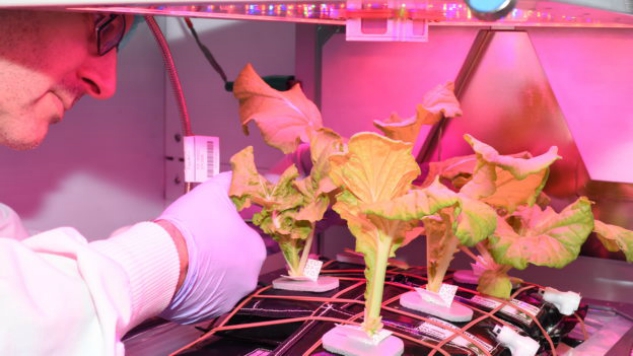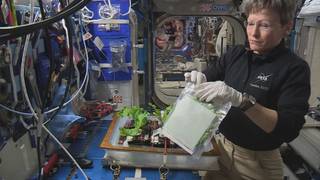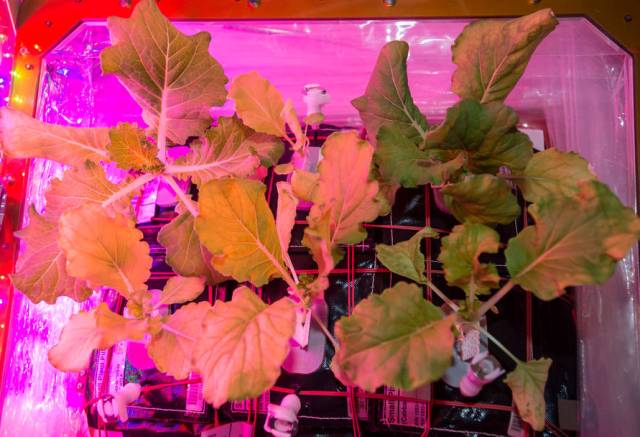
Space has always been a subject of doubts and vast possibilities and one more zenith has been achieved by the NASA, when cabbage was grown in the space shuttle. This would be the fourth crop that is grown in the space.
NASA for long has been looking forward to make the cultivation of vegetable on the space station a success. The vegetable experiment had been a long-awaited harvest for the astronauts, who say that the ability to grow and sustain crops in space may someday aid travelers on long space trips. Cultivating crops is seen as a critical step in the path to traveling to Mars, for instance.
After spending nearly a month tending to the International Space Station’s first crop of Chinese cabbage, astronaut Peggy Whitson harvested the leafy greens on Feb. 17. At first, one of the six seeds of the Tokyo Bekana Chinese cabbage variety seemed to have been planted higher than the rest, keeping it from getting wet enough in the beginning. But the on-orbit gardener would not be deterred.
“Peggy is doing an amazing job,” said Veggie Project Manager Nicole Dufour. “She wouldn’t give up and she was able to get the seed in pillow D to germinate.”

While the space station crew will get to eat some of the Chinese cabbage, the rest is being saved for scientific study back at Kennedy Space Center. This is the fifth crop grown aboard the station, and the first Chinese cabbage. The crop was chosen after evaluating several leafy vegetables on a number of criteria, such as how well they grow and their nutritional value. The top four candidates were sent to Johnson Space Center’s Space Food Systems team, where they brought in volunteer tasters to sample the choices. The Tokyo Bekana turned out to be the most highly rated in all the taste categories.
The NASA has quoted, "Astronauts often report that their taste buds dull during spaceflight, and they frequently add hot sauce, honey or soy sauce to otherwise bland-tasting fare. One explanation for this may be that, in a reduced gravity environment, the fluid in astronauts’ bodies shifts around equally, rather than being pulled down into their legs as we're accustomed to on Earth. The fluid that fills up their faces feels similar to the congestion from a cold and reduces their ability to smell. Researchers suggest this phenomenon combined with all the other odors aboard the confined orbiting laboratory competing with the aroma of their food may ultimately dull their sense of taste."
However, there is a backup plan to ensure the crew’s culinary delight. If the fresh Chinese cabbage they grew doesn’t awaken their taste buds on its own, packets of ranch dressing were also sent up to help them enjoy the fruits (or veggies) of their labor.
There are two exciting prospects on the horizon. Later this spring, a second Veggie system will be sent up to be seated next to the current one. It will provide side-by-side comparisons for future plant experiments and will hopefully make astronauts like Whitson happy to have a bigger space garden.

To be Sooner in the Space
Additionally, NASA has more plans for the future. The next resupply mission to the space station will be an experiment involving Arabidopsis, a small flowering plant, and petri plates inside the Veggie facility. Arabidopsis is the genetic model of the plant world, making it a perfect sample organism for performing genetic studies. The principal Investigator is University of Florida’s Dr. Anna Lisa Paul.
“These experiments will provide a key piece of the puzzle of how plants adjust their physiology to meet the needs of growing in a place outside their evolutionary experience,” Dr. Paul said. “And the more complete our understanding, the more success we will have in future missions as we take plants with us off planet.”
Later this year, the Advanced Plant Habitat, NASA’s largest plant growth chamber, will make its way to the station, increasing the amount of scientific knowledge needed to dig deeper into long-duration food production for missions farther and farther from home.










